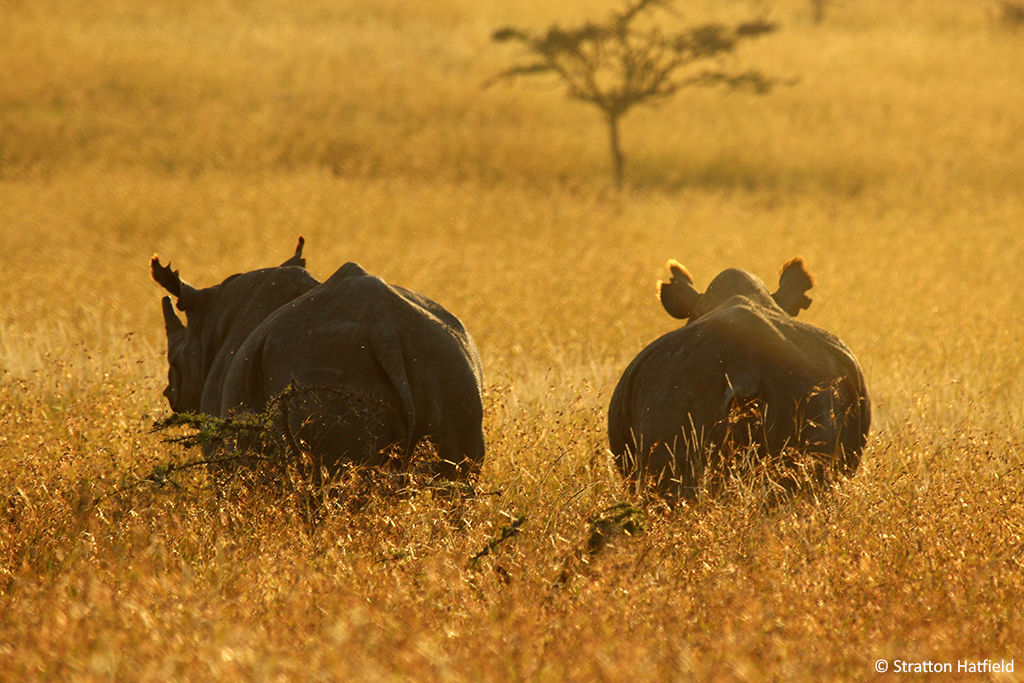IUCN and GIZ launch review of best practice in wildlife law enforcement in Sub-Saharan African protected areas
Around the world, wildlife is being depleted by illegal activities at an alarming rate, depriving local populations and national economies of important natural capital.

Best practice in wildlife crime prevention can help protect threatened species not least African rhinos
Photo: Stratton Hatfield
Moreover, this loss has a significant impact on national and regional security. Poaching in Sub-Saharan Africa for example has been subject to a growing professionalization, largely controlled by armed groups that are increasingly organised in international networks due to large profit margins.
In 2015, for example, more than 1,300 rhinos were poached in Sub-Sahara Africa, and over 20,000 elephants Africa-wide. In addition, many other mammal species are being targeted, not to mention plants, birds, reptiles and even invertebrates. The illegal wildlife trade is a global problem affecting terrestrial and aquatic species alike.
What is the best way to protect wildlife on the ground from the growing threat of increasingly sophisticated poaching and trafficking networks? A new joint publication from IUCN and GIZ addresses that complex question in the context of Sub-Saharan African protected areas.
This review, which was conducted in cooperation with the Conservation Development Centre (CDC) and Frankfurt Zoological Society (FZS), presents a series of principles of best practice from the field. In so doing, the authors aim to equip protected areas managers and related professionals in government, local communities, the private sector and NGOs with practical examples to support their patrolling, management and intelligence gathering work.
“Law enforcement is one important part of the response to the illegal wildlife trade. We will disseminate these best practices to all those working courageously to combat poaching and the illegal wildlife trade, including all organisations supported through our SOS Initiative. This publication complements other initiatives emphasizing the need to go “beyond enforcement” and work with the local communities. We need diverse and complementary efforts all along the supply chain from Africa to Asia to stop the trade” said Jean-Christophe Vié, Deputy Director of IUCN’s Global Species Programme and SOS Director.
Meanwhile the broad cross-section of issues that are addressed in the report highlights the reality that there are no stand-alone or universal solutions to tackling wildlife poaching in protected areas. Every situation is different – depending on geographies, species and resources available to name a few relevant factors.
Instead, the underlying analyses imply that successful wildlife law enforcement in protected areas depends on sustained and well-targeted actions across a number of inter-related components in three main fields: patrolling, management and intelligence gathering.
With more than 7,600 protected areas across the African continent, many famous for their wildlife as much as their geography and ecology, the fundamental value of effectively protecting this natural heritage relies on ensuring a strong connection between governance and practice. This publication supports that aim.
Commenting on the importance of this publication to addressing wildlife crime, Edgar Kaeslin, Advisor with the GIZ Polifund project to combat poaching and illegal wildlife trade in Africa and Asia, said, “this report takes a realistic and pragmatic look at the law enforcement approaches the professionals themselves know to work well, founded on the conviction that many protected area managers expressed to the report authors: ‘There is no substitute for a well-equipped, well-trained, and highly motivated ranger’.”
Note about IUCN
IUCN is a membership Union composed of both government and civil society organisations. It harnesses the experience, resources and reach of its 1,300 Member organisations and the input of some 15,000 experts. IUCN is the global authority on the status of the natural world and the measures needed to safeguard it.
Note about GIZ
The Deutsche Gesellschaft für Internationale Zusammenarbeit (GIZ) GmbH is a global service provider in the field of international cooperation for sustainable development with around 16,400 employees. GIZ has over 50 years of experience in a wide variety of areas, including economic development and employment, energy and the environment, and peace and security. As a public-benefit federal enterprise, GIZ supports the German Government – in particular the Federal Ministry for Economic Cooperation and Development (BMZ) – and public and private sector clients in around 130 countries in achieving their objectives in international cooperation. With this aim, GIZ works together with its partners to develop effective solutions that offer people better prospects and sustainably improve their living conditions.
The Polifund project on combating poaching and the illegal trade in ivory and rhino-horn, implemented by GIZ on behalf of the German Federal Ministry for Economic Cooperation and Development (BMZ) and the German Federal Ministry for Environment, Nature Conservation, Building and Nuclear Safety (BMUB), combines the expertise and resources of five German ministries, international organizations, NGOs and the private sector to combat poaching and the illegal trade in wildlife products (ivory and rhino-horn) in Africa and Asia.
Note about SOS
Created in 2010, SOS – Save Our Species is a joint initiative of IUCN, the Global Environment Facility and the World Bank. Its objective is to ensure the long-term survival of threatened wildlife, their habitats and the people who depend on them.
With a portfolio of 109 projects implemented by 78 conservation organisations in 65 countries protecting 250 threatened species of plants and animals, SOS has funded 12 anti-poaching related projects in Protected Areas across the Sub-Saharan region.



